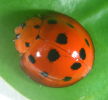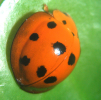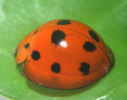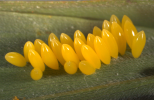Scientific name
Megalocaria dilatata (Fabricius) (=Caria dilatata, Anisolemnia dilatata)
This species was transferred to Megalocaria by Iablokoff-Khnzorian (1982), but the name Anisolemnia dilatata is more widely known and used in the literature.
Taxonomic position
Coleoptera: Coccinellidae: Coccinellinae: Coccinellini
Diagnosis
Length 10.0-12.5 mm, width 9.0-10.0 mm. Form round, hemispherical and strongly convex. Ground colour bright reddish/orange yellow with black markings as follows: head (Fig. 1) with a transverse basal marking and a pair of elongate, oblique spots on either side of lower margin of eyes, two oval spots (one on either side above scutellum) on posterior margin of pronotum and ten black spots on elytra arranged in a 1-2-2 pattern. Scutellum black. Ventral side uniformly reddish or yellowish brown.
Elytra slightly asymmetrical, with one elytron slightly longer than the other. Postcoxal line on abdominal ventrite 1 incomplete (Fig. 3). Male genitalia (Figs. 5-6) and female spermatheca (Fig. 4) as illustrated. Larva bluish grey and orange, with a thin powdery dust on dorsal side.
 Figs.1-6. Megalocaria dilatata (Fabricius): 1. Head; 2. Antenna; 3. Postcoxal line on abdominal ventrite 1; 4. Female spermatheca; 5-6. Male genitalia: 5. Tegmen, ventral view; 6. Sipho. Figs.1-6. Megalocaria dilatata (Fabricius): 1. Head; 2. Antenna; 3. Postcoxal line on abdominal ventrite 1; 4. Female spermatheca; 5-6. Male genitalia: 5. Tegmen, ventral view; 6. Sipho.Images





 Adult Adult
 Eggs on bamboo Eggs on bamboo


 Larva of A. dilatata Larva of A. dilatata
Distribution
India: Assam; Himachal Pradesh; Karnataka; Kerala; Tamil Nadu; Uttar Pradesh; northeastern region. Nepal.
Prey / Associated habitat
HEMIPTERA: Aphidoidea: Adelges spp. on silver fir, Aphis nasturtii
Kaltenbach, Astegopteryx (as Oregma) bambusae (Buckton), Astegopteryx minuta (van der Goot), Ceratovacuna (as Oregma) lanigera Zehntner, Ceratovacuna silvestrii (Takahashi), Cervaphis schouteniae van der Goot, Greenideoida ceyloniae van der Goot, Pentalonia nigronervosa Coquerel, Pseudoregma (as Oregma) bambusicola (Takahashi), Pseudoregma bucktoni Ghosh et al., Pyrolachnus (as Lachnus) pyri (Buckton) on pear, Toxoptera aurantii (Boyer de Fonscolombe). Collected on sandal.  Astegopteryx bambusae on bamboo, preferred prey of A. dilatata Astegopteryx bambusae on bamboo, preferred prey of A. dilatataUsually found along with Synonycha grandis (Thunberg) on aphids infesting bamboo ( Bambusa arundinacea), but less abundant. It is more commonly found feeding on the bamboo leaf aphid ( A. bambusae). Its seasonal occurrence, feeding habits and life history in general, closely resemble those of S. grandis (Puttarudriah & Channabasavanna, 1953). It survives and reproduces on aphids infesting cowpea, groundnut, cotton, pea, rose, jack, brinjal, cabbage, radish, citrus, sorghum, etc. in the laboratory, but apparently bamboo aphids are essential/preferred food.
Seasonal occurrence
Particularly abundant on bamboo during July-December in and around Bangalore (Puttarudriah & Channabasavanna, 1953), and January-February in northeastern region (Agarwala et al., 1984). Collected during March, June-July, and September-November in South India.
References
- Agarwala, B.K., Saha, S. & Ghosh, A.K. (1984) Studies on Ceratovacuna
silvestrii (Takahashi) (Homoptera: Aphididae) and its predator Anisolemnia dilatata (Fab.) on Bambusa arundinacea. Records of the Zoological Survey of India, 81, 23-42.
- Iablokoff-Khnzorian, S.M. 1982. Les Coccinelles Coleopteres-Coccinellidae Tribu Coccinellini des regions Palearctique et Orientale. Boubee, Paris, 568 pp.
- Puttarudriah, M. & Channabasavanna, G.P. 1952. Two giant ladybird beetles predaceous on aphids in Mysore. Indian Journal of Entomology 14: 20.
- Puttarudriah, M. & Channabasavanna, G.P. 1953. Beneficial coccinellids of Mysore-I. Indian
Journal of Entomology 15: 87-96.
|